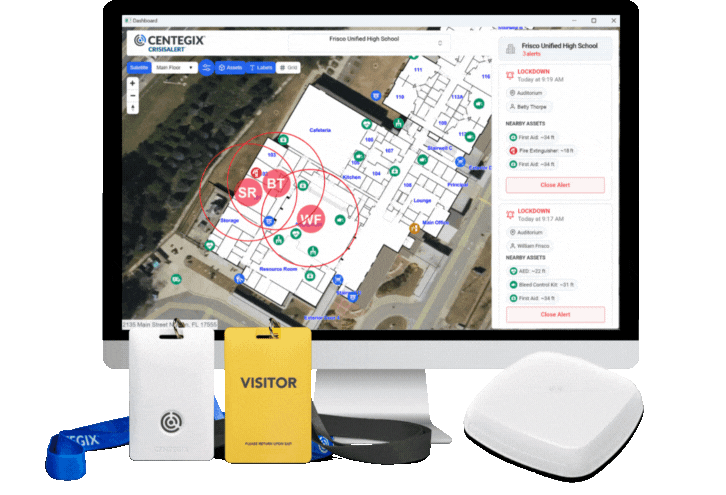The topic of healthcare security has never been more important than it is today. Defined as an “act or threat of violence, ranging from verbal abuse to physical assaults directed toward persons at work or on duty,” occupational violence can happen to any type of worker. From physical injury to psychological abuse, violence in the workplace has many forms and can have devastating implications for workers.
While workplace violence transcends disciplines and can impact any industry, healthcare workers experience a disproportionate amount of violence in the workplace. In a survey by Perceptyx, over 90% of healthcare workers experienced or witnessed workplace violence in the last 30 days.As such, workplace violence safety plans are a necessary tool–and comforting form of assurance–your hospital or healthcare setting can implement to combat workplace violence against healthcare workers.
Ensuring a workplace safety plan is set in place at your healthcare facility will help you, your employees, and your patients feel safe and protected if a situation suddenly turns violent. CENTEGIX recognizes the significant and continued threats of violence healthcare workers face today, which is why we are committed to preventing workplace violence for our customers in every way we can. We know every second matters in a crisis. With our wearable CrisisAlert emergency badge and our strategies for developing a workplace safety plan, CENTEGIX is dedicated to preventing violence and helping your hospital or healthcare facility provide the care patients deserve.
The Importance of a Workplace Safety Protocol

Workplace violence safety plan
Workplace safety plans are crucial to preventing violence. Because workplace violence can happen to any worker, establishing a successful workplace safety protocol to manage dangerous situations should be a top concern for employers and employees.
Reducing violence in the workplace begins with identifying risk factors that increase the chances of a violent situation arising in your work environment. Building an appropriate safety protocol based on these findings, and ensuring all workers understand the protocol and policies, reduces the likelihood of violence and promotes a safer workplace.
Healthcare workers are 12 times more likely to experience workplace violence than workers in any other industry, with 75% of all incidents of workplace violence involving healthcare workers.
Types of Workplace Violence Incidents: Emergencies and Common Occurrences
The CDC has identified four main types of workplace violence:
- Criminal Intent – The perpetrator lacks a legitimate relationship with the business/employee.
- Customer/Client – Most common in healthcare, the perpetrator (client) has a relationship with the victim (provider).
- Worker-on-Worker – This typically presents as verbal or emotional abuse occurring between workers, often between supervisor and employee.
- Personal Relationship – The perpetrator has an external relationship with the victim which leads to a workplace incident.
Violent and non-violent behavior comes in many forms, though five forms are most prevalent as experienced by healthcare workers:
- Verbal abuse (61.2%)
- Psychological violence (50.8%)
- Threats (39.5%)
- Physical violence (13.7%)
- Sexual harassment (6.3%)
Because of the variability in the kinds of workplace violence incidents, some workers struggle when deciding whether to report. Unfortunately, barriers to reporting workplace violence in healthcare are very real and felt by plenty of workers. Workers often fail to report incidents or abuse they view as routine or not serious enough to warrant investigation. No form of violence is acceptable. Always report any incident that makes you feel uncomfortable, especially if it relates to the types and forms of workplace violence above.
The Recent Increase in Workplace Violence in Healthcare

Workplace violence safety plan
The COVID-19 pandemic has had an undeniable impact on the increasing rates of workplace violence in healthcare. Healthcare personnel have faced an onslaught of abuse throughout the pandemic, sometimes incurring stigmatization, ostracization, and abuse just for treating people with the virus.
From the emergency room to senior care facilities, healthcare workers across disciplines within the field are feeling the effects. The International Committee of the Red Cross found that in the first six months of the pandemic, healthcare workers suffered 611 incidents of workplace violence. Many healthcare researchers cite underreporting as a major problem during the pandemic, with studies estimating that 60% of workplace violence in healthcare goes unreported.
Because of the stress the pandemic has placed on our nation’s healthcare system, healthcare providers have collectively recognized an urgent need for new workplace violence prevention guidelines.
Why is Healthcare a High-Risk Profession for Workplace Violence?
Though the COVID-19 pandemic certainly appears to have escalated the frequency of violent attacks against medical professionals, violence against healthcare workers was increasing in the years before the pandemic. The rate of injuries resulting from physical attacks against healthcare professionals rose 63% between 2011 and 2018.
What makes healthcare so susceptible to workplace violence?
The healthcare facility is a unique setting influenced by various internal and external considerations. From demanding workloads to societal and economic uncertainties to excessive work pressures, workplace conditions in healthcare seem to form the perfect storm for potentially violent situations to arise. A variety of factors combine to increase the likelihood of workplace violence in healthcare, including:
- Treating or working with people who have a history of violence
- Working in locations with high rates of crime
- Inadequate environmental design, such as blocked escape routes or poor lighting
- Understaffing, especially during visiting hours and meal times
- High employee turnover
- Long wait times and overcrowded waiting areas
- Lack of a workplace violence safety plan and/or staff emergency training
- Poor security measures
Not all healthcare workers are treated equally when it comes to workplace violence incidents.
In April 2022, 48% of nurses reported an increase in workplace violence at their healthcare location, up 119% from March 2021. What’s more, 69% reported that staffing and “floating” reassignments have worsened over the past year—a clear indicator of an increase in workplace violence. A recent study found that psychiatric professionals experience the highest rates of workplace violence of any other healthcare discipline.
Working outside the traditional hospital setting poses a distinctive threat to medical professionals, due to their working alone in an uncontrollable work environment. 61% of home healthcare and geriatric care workers have experienced violent incidents in the workplace, ranging from verbal attacks to physical assaults.
Emergency care workers also face an alarming amount of workplace violence. 70% of emergency nurses say they have been hit or kicked on the job. With 80% of emergency physicians confirming violence in their department harms patient care, the need for effective healthcare security and workplace violence safety plans has never been greater.
Legislative Action Toward Stronger Healthcare Security

Workplace violence safety plan
Workplace violence against healthcare workers has become so prevalent that just last year, Congress took notice. In April 2021, the House of Representatives passed the Workplace Violence Prevention for Health Care and Social Service Workers Act, which directs the Secretary of Labor to “issue an interim final standard requiring employers in the health care and social service sectors to develop and implement a workplace violence prevention plan” in accordance with OSHA’s guidelines.
The guidelines, published by OSHA in 2016, were designed with the full spectrum of healthcare settings in mind. The guidelines feature five steps providers should take when creating a workplace violence prevention program or safety plan:
- Management Commitment and Worker Participation
- Worksite Analysis and Hazard Identification
- Hazard Prevention and Control
- Safety and Health Training
- Recordkeeping and Program Evaluation
National Nurses United (NNU), the largest union of registered nurses in the country, strongly supports the proposed bill introduced in the Senate this past May.
As NNU President Jean Ross, RN explains, “Nurses across the country…are bearing the brunt of a broken health care system at a time when people’s frustration and stress are at their highest. Nurses report being punched, kicked, bitten, beaten, and threatened with violence as they provide care to others…We need the Workplace Violence Prevention for Health Care and Social Service Workers Act to help protect us on the job, so we can continue to care for you, your loved ones, and our communities.”
Healthcare legislatures have also noticed the increase in hospital violence throughout the past decade. In June 2021, the Joint Commission issued new Workplace Violence Prevention Standards for hospitals to target workplace violence in healthcare. The new standards put forth by the Joint Commission require healthcare administrators to:
- Manage safety and security risks through worksite analysis.
- Monitor conditions in the work environment, including reports made by workers.
- Require staff to participate in continuous education and training as part of a workplace violence prevention program.
- Empower leadership to maintain a workplace culture that promotes safety and quality.
These standards and those of the like ensure your workplace violence safety plan is not only effective in preventing violence in the workplace but also shows your staff that they are cared for and protected.
What Traditional Safety Protocol Looks Like With Healthcare Security in Mind

Workplace violence safety plan
Healthcare security should be a central component within your workplace violence safety plan. Traditional approaches to safety protocol often focus on reactive strategies, rather than preventative measures. When revisiting your workplace’s violence prevention plan, recognize that safety protocols are not one-size-fits-all. Consider what adjustments need to be made to address current threats posed to healthcare workers in a given healthcare setting.
Conflict Resolution Strategies: Discretion and De-escalation
Understanding conflict resolution strategies is integral to a successful workplace violence safety plan focused on healthcare security. De-escalation is key to preventing a situation from becoming violent in the workplace.
OSHA describes de-escalation as “a combination of strategies, techniques, and methods intended to reduce a patient’s agitation and aggression.” Among these techniques are “communication, self-regulation, assessment, actions, and safety maintenance” which demonstrate a commitment to both staff and patient wellbeing.
Create a multifaceted plan to ease tension in your healthcare setting. Focus on patient, staff, and environmentally centered approaches that empower team members to de-escalate a potentially violent situation.
Because of the variety of healthcare settings, each workplace should tailor a sustainable workplace violence safety plan to its specific needs. Healthcare administrators must establish a safe, trusted, and discreet environment for their employees, so every staff member is comfortable reporting a violent incident and knows they will be taken seriously.
CrisisAlert Badge and CENTEGIX’s Commitment to Workplace Safety in Healthcare

Workplace violence safety plan
In emergencies, every second matters. The CENTEGIX CrisisAlert badge is a simple, reliable, and remote way to mitigate the risk of workplace violence in healthcare.
The CrisisAlert badge is a discreet, wearable device that allows you to instantly call for help during an emergency. CrisisAlert uniquely allows you to customize who gets notified during different types of emergency situations:
- Active shooters
- Verbal or physical attacks
- Bomb threats
- Hostage situations
- Extreme weather events
Regardless of your location within the workplace, CrisisAlert provides full coverage for your healthcare staff.
Moreover, because it requires no change to your workplace’s physical infrastructure, CrisisAlert can be installed with minimal disruption to healthcare workers or their patients.
Leadership from education systems around the country are investing in CrisisAlert, praising its ease of use and instant connection to emergency first responders. CrisisAlert has been a nationwide game-changer for teachers, students, and staff. Thanks to CrisisAlert:
- A student’s life was saved during a medical emergency in class.
- Two intruders who jumped a school’s fence were quickly scared off by audible and visual warnings.
- During a school lockdown, law enforcement removed the threat from campus in minutes.
CENTEGIX’s CrisisAlert badge has had inspiring/compelling results in education. As we continue to expand in healthcare, we’re excited to connect with healthcare systems considering an instantaneous emergency communication solution as part of their workplace violence safety plan.
Keeping people safe is our top priority. While you can’t always predict when an emergency will happen, integrating CrisisAlert into your workplace violence safety plan can give you and your staff peace of mind. With CrisisAlert, calling for help is as simple and immediate as the discreet press of a button.
A crisis can happen at any moment. That’s why—when seconds count—CENTEGIX has your back. The CrisisAlert badge provides indispensable communications coverage integral to a successful workplace violence safety plan.









